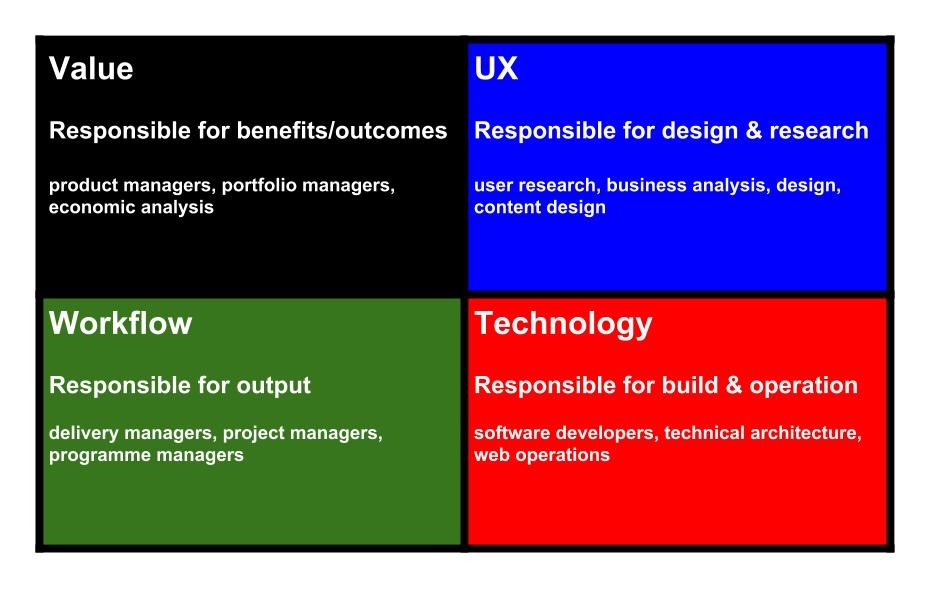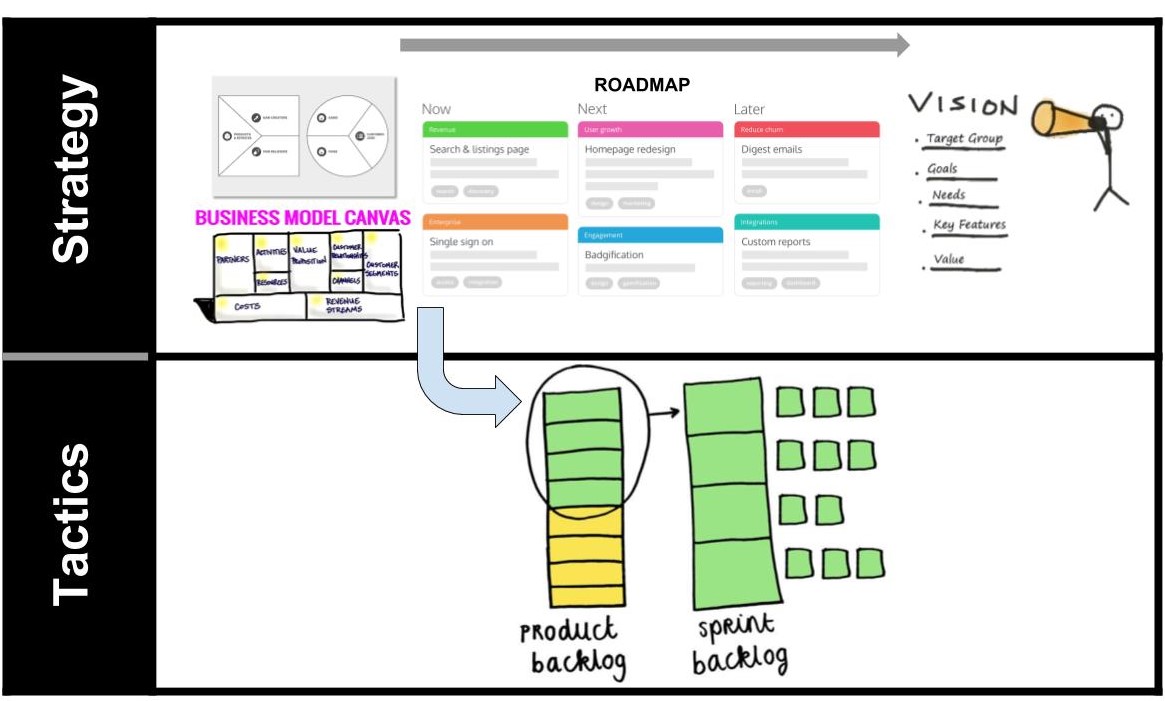What is product management in government?
The job of a product manager is to discover a product that is valuable, useable, and feasible. Product management is uniquely responsible for the value (aka benefits, aka outcomes) of products because it operates in the intersection between user experience (UX), workflow, technology, and business goals: passionate about solving problems but usefully flexible about the specific solution, providing guidance through a focus on the end goal (aka value/benefits/outcomes). Product management provides a generalist perspective amongst specialists, and is defined by its relationship with others. Product management is unique amongst the professions in that it works simultaneously with delivery teams, and executive management teams.
How does product management work within delivery teams?
Delivery teams require four different perspectives if they are to create valuable, feasible, user-centred products as a high-performing unit:
- Value
- Workflow
- User Experience (‘UX’)
- Technology.

What do we mean by each of these persepectives?
Value: Product management brings a perspective on value above all else, focussed on maximising business value from a product. Product managers should be primarily focussed on optimising a product to achieve business goals while maximising return on investment.
UX: Professions such as user research, business analysis, and design provide the perspective of users to the team, leading the understanding of users, the problems they face, and the way that products work in the real world. UX professionals should be focussed on talking to users, testing the products, and getting feedback first-hand above all else.
Technology: Professions such as software development, technical architecture, and web operations provide the perspective of the ‘makers and doers’ to the team, leading the understanding of the possible solutions to the users’ problems. Technology professionals should be focussed on improving the quality of their solutions through build-test-learn feedback loops above all else.
Workflow: Professions such as delivery management provide the perspective of output, leading the overall performance of the team and helping value, UX, and tech professionals to work together. Workflow professionals also lead on the team’s understanding of broader constraints and dependencies.
How does product management work with executive management teams?
Product management supports the business function of its organisation, helping to align the goals of products to the goals of the organisation - in order to do this, product management need to provide their delivery team with the perspective of their organisation, and looks to the organisation’s management teams to provide these goals. The interplay between executive management teams and product management represents the difference between business strategy and product strategy.
| Business strategy | Product strategy |
|---|---|
| “How will the business succeed?” | “How will the product succeed?” |
| Led by executive management teams | Led by product management + product teams |
| Clear, measurable, outcome-driven goals for what the organisation is to achieve | Clear, measurable, outcome-driven goals for how products will achieve the organisation’s goals |
| Empowers product management + product teams to own the product strategy | Trusted to figure out how to achieve the organisation’s goal by management teams |
Product management supports executive management teams in setting a business strategy and business goals that are feasible by advocating for the perspectives of their delivery team; once set, product management advocates for these goals within their delivery team.
Product management = Value
Product management acts as the intersection between the goals of the organisation, and the perspectives of their delivery team - it’s at this intersection that products become their most valuable, and so product management leads on value.

Product management is defined by its relationship with with others:
- Within a delivery team, product managers are generalists amongst specialists, aligning multiple perspectives into a clear product strategy and goals
- Within executive management teams, product managers bring the specialist perspectives of their delivery team to help influence business strategy and goals to improve their value and feasibility - then take these goals to their delivery team.
What is product management not?
Product management is commonly confused with project managementment - possibly because both professions are abbreviated to PM :) Project teams are temporary organisations where the solution and plan has been decided and the goal is to follow the plan successfully to the goal - projects are great are a great option for a delivery model in situations of high-certainty in a problem and high-agreement in a solution (this is the opposite of product teams, where only the outcome and resources are known - solution and plan are flexible and develop as we learn more).
Product management can also be confused with application owner or technology owner. Outsourced software or technology managed through pre-planned and agreed service level agreements requires an owner. These applications or technologies are products, and have owners/managers, so the in-house manager may be confusingly referred to as product owner or product manager - but is not fulfilling the role outlined in this guide - instead they are performing a different skilled and valuable role that is needed across government.
What does product management look like?
Product management is a relatively new profession within government, requiring a broad set of skills and understanding of multiple other professions - as shown in the previous section. All of this combines to make product management a difficult profession to learn without doing - meaning that’s it’s difficult to take a course or degree that will provide everything required to lead a product from day-one on the job - many product managers will tell you of the circuitous journey into their current role. This journey will begin by learning the tactics of product management, and then learning product management strategy.

Product management tactics
Product managers often begin by developing their product management tactics - taking the large goals outlined in the product strategy and breaking them down into SMART-er goals (specific, measurable, achievable, realistic, time-based) for their team (this is often called the product backlog) - the team will turn these goals into actionable tickets. The product manager will lead their team in planning and reviewing product increments in the format of rapid build-test-learn feedback loops (often known as ‘sprints’).
Product management strategy
Product managers move onto leadership of product strategy once they have mastered product management tactics. Product strategy involves:
- understanding the problem to be solved, and the conditions under which it is valuable to solve, feasible to solve, and pervasive, urgent, and valuable enough to make it worth solving - this is often expressed in its simplest terms through a ‘value proposition’, and then explored in more detail via business modelling
- building a vision that describes the desired-future-state, including value/benefits/outcomes needed to justify investing in the product
- running a ‘roadmap’ that promises value improvements/outcomes/benefits (but does not commit to specific features/solutions), connecting the problem as it stands today with the vision for how it will look in the future.
Product strategy is ‘live’ and should be reviewed at least once per month - it is not a static business case developed once, at the beginning of a product - it is a group of changing insights and conditions summarised in several strategic tools that help us to respond to change in a way that maintains the value of our products - or (ideally) to improve the value of our product over time.
Product management career pathway
A team is a team is a team. Product managers require the same tactical and strategic skills throughout their career. The specific implementation changes a little when moving from delivery team, to middle-management team, to leadership team - but the general principles remain the same. This is at the heart of the product management career pathway - the tactical and strategic expectations remain consistent but the scale and complexity changes.
- Associate Product Manager: Associate Product Managers begin with an awareness of product management and are expected to develop, through doing, until they become become a product management practitioner and graduate to full Product Manager. This journey will begin by learning the tactics of product management, and then learning product management strategy. Associates are ready to graduate to full Product Manager when they are a practitioner of product management tactics and strategy, capable of leading an entire product and product team on their own.
- Product Manager: Product Managers lead the product tactics and strategy for a product.
- Senior Product Manager: Senior Product Managers lead the product tactics and strategy for a group of products that share a value proposition. Senior PMs focus on the total value of the group of products, helping them to operate in relation to each other. This might involve re-prioritising one product in the group over another at times. Senior Product Managers are likely to be managing the product managers in their group. Senior PMs are likely to remain ‘hands-on’ in one more more products but may be working with Associate Product Managers who will pick up the product management tactics for individual products. Some Senior PMs may remain at work on a single product that is particularly complex or challenging - this is where we make most use of contractors, for example. However, they will need to move into the way of working outlined above in order to develop the expertise required to progress to lead product manager.
- Lead Product Manager: Lead Product Managers lead the product tactics and strategy for an entire business-unit, product-line, or end-to-end service. This might involve re-prioritising one product group over another at times. Lead Product Managers are a member of the management team for their product area, and are responsible for the overall performance and recruitment of their product community in their product area - ‘hands-on’ product management within delivery teams is likely to disappear as this approaches and exceeds ten product managers; there will be an increasing amount of work with their middle-management team. This represents the shift from ‘product management’ to ‘product leadership’.
- Head of Product: Head of Product supports/facilitates the product tactics and strategy for the organisation as a whole. This involves working closely with Portfolio & Controls through things like Triage, Prioritisation and Service Assessments. This might involve suggestions for business-units to explore shared opportunities that cross organisational boundaries. This is achieved by working closely with Lead Product Managers and their business units. Head of Product is responsible for the overall performance and recruitment of the product management profession, working closely with Lead Product Managers on this.
Product management handbook
All of this is explored in more detail in the Product Management Handbook with exaplantions, suggested reading, and useful courses.
Influences
Richard Banfield, Marting Erikson, Nate Walkingshaw, Product Leadership. O’Reilly, 2017.
Roman Pichler, “Why product people should care about business strategy”. Roman Pichler, 2018.
@lissijean (Melissa Perri), @joshuajames (Joshua J. Arnold), @tastapod (Dan North), “Delivery team perspectives”. Twitter, 18 February 2018.
Martin Eriksson, “What, exactly, is a Product Manager?”. Mind the Product, 2011.